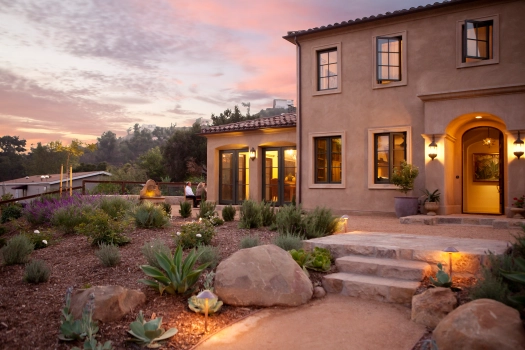The risk of natural wildfires is changing and growing. They’re not just relegated to the west coast anymore. Drought is spreading and increasing the chance of fire across the nation. As such an example, you might remember the wildfire last winter that devastated a Boulder, CO subdivision; not in the summer, not in a wooded area. First Street Foundation’s analysis reveals that a larger section of the country is in the crosshairs of wildfire danger. According to their research, almost 80 million properties in America are at significant risk of fire exposure. But if you are in one of these zones you’re not completely helpless. There are easy ways to add some protection with a fire resistant home landscape that can also be accomplished in an eco-sustainable manner.
Map shared from The Washington Post.
Every single person in the country has experienced firsthand how climate change has altered our weather patterns, with fewer showers of rain where water is needed; longer and stronger storms where it’s not. Hotter summers, colder, and longer winters. It’s drastic. If your area is prone to wildfires there are steps you can take to minimize the risk and improve the odds of your home’s survival compared to traditional landscaping. Let’s look at the different steps we can take to design a fire resistant home landscape to fit almost any aesthetic.
What is “Defensible Space”?
This is the foundation of wildfire-resistant landscaping. It refers to the space in two different zones around your home. It is a set of environmental design principles that helps to increase the chances of a fire passing by a house. And secondly, it also significantly increases firefighters’ capacity to defend a home at risk.
- You DO NOT have to keep all vegetation 100 feet away from your house. If this is done too drastically it can actually increase other environmental issues such as flooding and erosion.
- Large properties are divided into two zones.
- Zone 1 extends 30 feet out from your home.
- No plants touching the home.
- No trees or plants hanging over the house (especially near chimneys and windows).
- Space woody plants and islands of vegetation 10 or more feet apart to prevent fire from finding a path toward your home.
- Zone 2 extends the next 70 feet out.
- In this area, ground cover should be low.
- Spacing woody plants vertically and horizontally helps to reduce a fire’s ability to spread.
- Spacing guidelines will vary according to the slope of your property.
You can find detailed spacing guidelines for defensible space on the Cal Fire website. Californians are required by law to administer this method of management.
Don’t Give A Fire Extra Fuel
The whole point of fire-resistant landscaping is to remove as much as possible anything that might be fuel for the fire.
- Such as dead tree branches or other woody plants. Trim those away and add them to your county’s compost pick-up bin.
- During any dry seasonal times also make sure to clear plant litter from the ground.
- Keep your grassy areas mowed.
- Keeping the ground clear of organic matter, such as natural mulches, is a good practice.
- You can use materials like gravel instead.
- Wide, paved paths and inorganic mulches act as breaks in a potential fuel pathway. This reduces plant matter and increases the distance between plants.
- This kind of layout helps to prevent flames from easily jumping and continuing to spread.
Water Conservation
It’s a challenging balance to keep plants well-irrigated in drought prone areas. It has to come down to being creative while putting in a bit more extra effort.
- Any greenery you do have in the yard needs to stay hydrated as dry plants catch fire much easier.
- Even if it doesn’t rain frequently in your area, have a rain barrel on the property to take advantage of every time it does.
- Set up your irrigation system to use grey water from your home.
- Have buckets in your shower and by your sinks. You might be surprised how much water you can collect while waiting for it to get hot.
- With a defensible landscape in place, you will have less planted to water so it should be manageable.
Plants and Materials
- To save even more water, fill your garden and landscapes with native plants and nativars. These types of species thrive with less water than non-native species. Because wildfires are a natural part of environmental cycles in the western U.S., there are many fire-resistant native species.
- Many horticultural varieties of shrubs, perennials, and ground covers are fire resistant, as well.
- Look for high-moisture species with a compact shape and low sap or resin content.
- Check local nurseries for advice on fire-resistant plants suitable for your area.
- Other materials: be cognisant of your garden furniture and ornaments. Wood fences, outdoor fabric-covered chairs and sofas, and wood furniture act as additional fuel for fires.
Summary
With a defensible fire-resistant landscape in place can help prevent your home from burning. To learn more about preventing fires and preparing a wildfire action plan, check out the CalFire website and wildfire planning app for both Android and iOS.
#defensibledesign #remoov #landscaping #Landscape #firescaping #smartlandscaping #fireresistant #fireprotection #firesafety #fire #safety #fireprevention #safetyfirst #construction #nfpa #fires #homeprotection #design #firesafetytips #firesuppression #healthandsafety #xeriscape #succulents #xeriscaping #garden #cactus #waterwisegardening #gardening #droughttolerantplants #droughttolerant #waterwise #agave #landscapedesign #landscapearchitecture #drygarden #desertgarden #landscape #agaves #agaveplant #xeriscapegarden #succulentplant #succulentsofinstagram #cactusandsucculents

